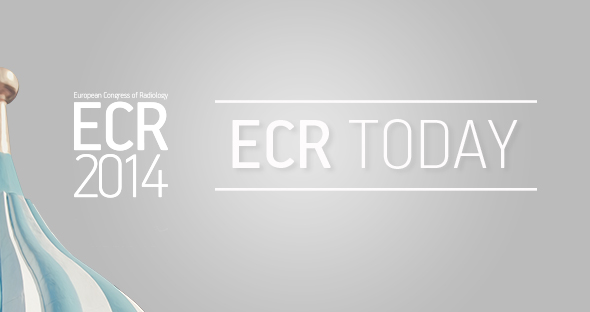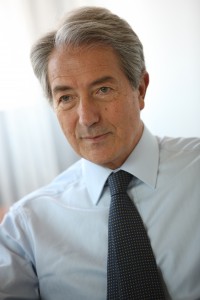New ESR President wants to draw national societies close
ECR Today caught up with incoming ESR President Professor Lorenzo Bonomo at ECR 2014, and asked him about his vision for the year to come.
ECR Today: What are your plans and ambitions regarding your presidency?
Lorenzo Bonomo: It is with great pride that I take on the presidency of one of the most important and prestigious international scientific societies in the world. I’m also particularly pleased that my presidency coincides with the ESR’s tenth anniversary, which we’ll be celebrating next year.
So much has been done over the past few years thanks to the work of my predecessors, the Executive Council, the statutory committees, subcommittees, working groups and the tireless and efficient support of the ESR staff. Many of the objectives in the roadmap approved in 2012 have been achieved together with other new important projects, started during Prof. Frija’s presidency, and it will be my duty to consolidate and bring them to a conclusion. Among them are the development of a clinical decision support system in Europe, the creation of an accreditation council, and a strengthening of relations with other scientific societies in Europe and the EuroSafe Imaging Campaign. The whole learning, education and training field certainly requires close attention and a collaborative vision.
I would also like to draw the national societies closer, by intensifying dialogue with them, trying to understand their needs, and helping them to promote and increase the visibility of radiology. I would like my role to be that of a facilitator supporting the ongoing projects and promoting the start of new activities that committee chairpersons intend to achieve.
ECRT: The ESR launched the EuroSafe Imaging Campaign during ECR 2014 to promote radiation protection throughout Europe. How will it do so exactly?
LB: We established a steering committee, consisting of various stakeholder representatives, to plan, coordinate and implement the activities. Members include the chair of the National Societies and Subspecialty and Allied Sciences Committees, as well as representatives of the ESPR, CIRSE, EFOMP, EFRS, COCIR, and a patient representative (and potentially an observer from the European Commission). We also plan to develop lists of criteria for safe radiological examinations. Additionally, the criteria for each examination will be applied to specific body parts and be available in many European languages. Last but not least, we will develop training material and electronic self-assessment modules on radiation protection topics.
ECRT: The official endorsement of the ESR’s European training curriculum for radiology by the radiology section and council of the European Union of Medical Specialist is a very significant achievement. How will the ESR further promote harmonisation of training in Europe?
LB: This official endorsement and the support of national societies are an important acknowledgement of the work carried out by the ESR Education Committee and its chairperson, Birgit Ertl-Wagner. The next step is the publication of Level III, regarding the subspecialties, which will complete the whole training path.
Unfortunately, residence training in Europe is not homogenous; training ranges from two to six years depending on the country. Therefore, harmonisation is quite a long way off. What the ESR can and is trying to do is invest in training and education, and so we decided to introduce an eLearning platform. All the educational material available from all sources (ECR, ESOR, EDiR, EPOS, EURORAD, etc.) will be collected and combined, and a link between education and certification will be created. The objective is to create something different from the existing offers on the market. The curriculum, the existing education tool, and the ones that will be soon created – like the eLearning platform – are tools that the ESR will increasingly use to encourage the harmonisation of European training. We hope that these initiatives will be followed by political developments across Europe.
ECRT: Another positive development is the growing recognition of the European Diploma in radiology (EDiR). How important is it for a resident or radiologist to sit the examination?
LB: EDiR, like any new process, needs some time to develop. Today, it represents an unofficial certification of excellence in most countries, with the exception of Poland, Turkey and Catalonia, where official recognition has been achieved. But I think that in a few years, transnational certification will be required in Europe for every medical specialisation. In 2013, 157 candidates from 27 countries took the diploma, 30% more than in 2012. There is also great interest from radiologists working outside Europe. I hope it will soon be possible to hold an EDiR exam in Italy as well. In a world where migration between countries is increasing, having EDiR on one’s CV represents is definitely an advantage.
ECRT: As director of the Training Programme in Radiology at the Catholic University of Rome, you are committed to educating younger radiologists. What do you think of initiatives like the ESR’s Rising Stars or Invest in the Youth?
LB: Young people represent our future. Every year, my residents take part in the ‘Invest in the Youth’ programme and, over the years, many of the them have had the chance to attend the ECR and will continue to do so his year.
The ESR, through the European School of Radiology (ESOR), encourages the training of young people with many activities and therefore, we will continue to invest in the education of young radiologists.




Hear,hear!